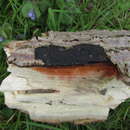en
names in breadcrumbs


Hypoxylon tinctor is a plant pathogen and saprophyte of dying or weakened trees such as sycamore, oak, or elm. The fungus causes cankers on large branches or the tree trunk. Ascospores of this fungus are transported by wind or rain that can infect existing wounds in trees.[1][2] It can be identified by orange staining that can be seen on cut wood, and it has protruding ostioles.[3]
Hypoxylon tinctor is a plant pathogen and saprophyte of dying or weakened trees such as sycamore, oak, or elm. The fungus causes cankers on large branches or the tree trunk. Ascospores of this fungus are transported by wind or rain that can infect existing wounds in trees. It can be identified by orange staining that can be seen on cut wood, and it has protruding ostioles.